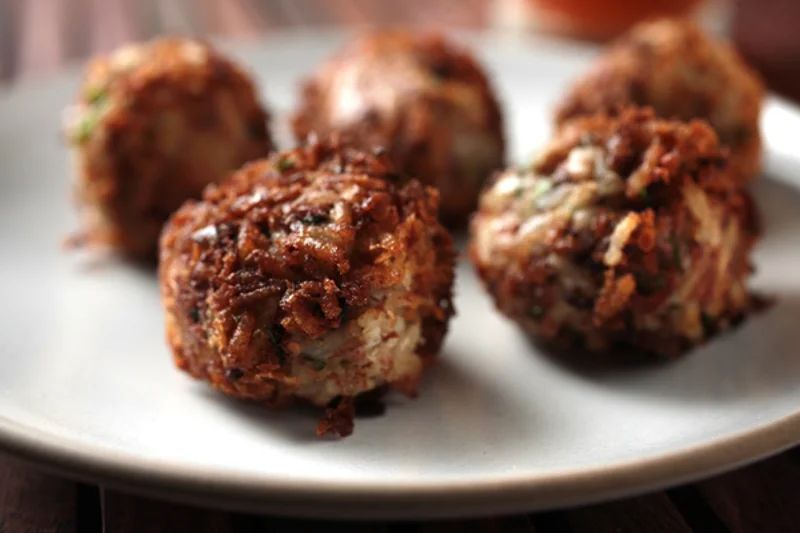Boudin, the king of Cajun food, is my favorite thing in the world to eat. It is a unique food in that it can be breakfast, lunch, dinner, a snack, or car food. Whereas most of the country might show up at a morning get-together with donuts, we show up with boudin. And no two boudins are exactly alike—that’s amazing, considering they all have basically the same ingredients of rice and pork.
One of the best boudins I’ve had is made by my cousin Bubba Frey, who owns the Mowata General Store in the heart of the German settlement between the Link and Zaunbrecher rice fields, but all my cousins down there make their own boudin. One cousin told me that meat from the temple of the pig’s head makes the best boudin, while another claims that a combination of hog jowl and shoulder meat is the secret. The truth is, they are all good.
This recipe combines elements from all of the different boudins I’ve eaten in my day. There’s liver in it but just enough, it’s nicely spiced but won’t burn your mouth, and it has the perfect amount of rice.
Special equipment: You will need a deep-frying/candy thermometer for this recipe.
What to buy: Panko is coarse Japanese-style breadcrumbs, available in many grocery stores.
Curing salt, also known as pink salt or saltpeter, contains 6.25 percent sodium nitrite. It is colored pink so as not to be confused with regular salt. Curing salt is available at Butcher & Packer.
This recipe was featured as part of our Mardi Gras Recipes photo gallery.
- Yield: Makes 4 pounds (about 50 balls)
Ingredients (18)
- 2 pounds boneless pork shoulder, cut into 1-inch cubes
- 1/2 pound pork liver, cut into 1-inch cubes
- 2 celery stalks, chopped
- 1 small onion, chopped
- 6 garlic cloves, coarsely chopped
- 3 medium jalapeños, stemmed, seeded, and chopped
- 1 medium poblano chile, stemmed, seeded, and chopped
- 4 tablespoons kosher salt
- 2 tablespoons freshly ground black pepper
- 1 tablespoon freshly ground white pepper
- 2 teaspoons cayenne pepper
- 1/2 teaspoon curing salt
- 1 teaspoon chili powder
- 7 cups cooked white rice
- 1 cup chopped parsley
- 1 cup chopped scallions (green and white parts)
- 3 cups panko
- Vegetable oil, for frying
Instructions
- Combine the pork, liver, vegetables, and seasonings in a bowl and marinate for 1 hour or overnight, covered, in the refrigerator. Place the marinated mixture in a large pot and cover the meat with water by 1 to 2 inches. Bring to a boil, reduce the heat, and simmer until the meat is tender, about 1 hour and 45 minutes.
- Remove the pot from heat and strain, reserving the cooking liquid. Allow the mixture to cool slightly, then put the solids through a meat grinder set on coarse grind. (You can also chop with a knife if you don’t have a meat grinder, which is what I usually do anyway.)
- Place the ground meat in a large bowl. Using a wooden spoon or rubber spatula, mix in the cooked rice, parsley, scallions, and 3 1/2 cups of the reserved cooking liquid. Stir vigorously for 5 minutes until the mixture sticks together when pressed with the back of a spoon, adding more cooking liquid as necessary. (Feel free to use a mixer if you have one. I have one yet I still mix it by hand for some reason I can’t explain.)
- Place the panko in a wide, shallow dish. Form the boudin mixture into golf-ball-sized rounds, roll in the panko, place on a baking sheet, and set aside.
- Heat the oven to 200°F and arrange a rack in the middle. Line a baking sheet with a few layers of paper towels.
- Pour 2 inches of vegetable oil in a Dutch oven or a large, heavy-bottomed pot. Heat over high heat until the oil reaches 375°F on a deep-frying/candy thermometer. Add boudin balls in a single layer (you’ll need to do this in batches so as not to crowd the pot). Fry until golden brown in color and heated all the way through, about 1 minute. Transfer to the paper-towel-lined baking sheet using a slotted spoon. Place the baking sheet in the oven to keep the boudin balls warm.
- Return the oil to 375°F and repeat the process with the remaining boudin balls.
Recipe provided by Chef Donald Link, author of “Real Cajun: Rustic Home Cooking from Donald Link’s Louisiana.”


